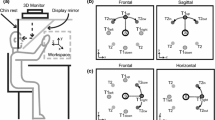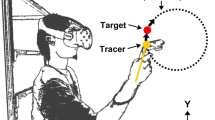Abstract
Reaching toward a visual target involves the transformation of visual information into appropriate motor commands. Complex movements often occur either while we are moving or when objects in the world move around us, thus changing the spatial relationship between our hand and the space in which we plan to reach. This study investigated whether rotation of a wide field-of-view immersive scene produced by a virtual environment affected online visuomotor control during a double-step reaching task. A total of 20 seated healthy subjects reached for a visual target that remained stationary in space or unpredictably shifted to a second position (either to the right or left of its initial position) with different inter-stimulus intervals. Eleven subjects completed two experiments which were similar except for the duration of the target’s appearance. The final target was either visible throughout the entire trial or only for a period of 200 ms. Movements were performed under two visual field conditions: the virtual scene was matched to the subject’s head motion or rolled about the line of sight counterclockwise at 130°/s. Nine additional subjects completed a third experiment in which the direction of the rolling scene was manipulated (i.e., clockwise and counterclockwise). Our results showed that while all subjects were able to modify their hand trajectory in response to the target shift with both visual scenes, some of the double-step movements contained a pause prior to modifying trajectory direction. Furthermore, our findings indicated that both the timing and kinematic adjustments of the reach were affected by roll motion of the scene. Both planning and execution of the reach were affected by roll motion. Changes in proportion of trajectory types, and significantly longer pauses that occurred during the reach in the presence of roll motion suggest that background roll motion mainly interfered with the ability to update the visuomotor response to the target displacement. Furthermore, the reaching movement was affected differentially by the direction of roll motion. Subjects demonstrated a stronger effect of visual motion on movements taking place in the direction of visual roll (e.g., leftward movements during counterclockwise roll). Further investigation of the hand path revealed significant changes during roll motion for both the area and shape of the 95% tolerance ellipses that were constructed from the hand position following the main movement termination. These changes corresponded with a hand drift that would suggest that subjects were relying more on proprioceptive information to estimate the arm position in space during roll motion of the visual field. We conclude that both the spatial and temporal kinematics of the reach movement were affected by the motion of the visual field, suggesting interference with the ability to simultaneously process two consecutive stimuli.







Similar content being viewed by others
References
Aslin RN, Shea SL (1987) The amplitude and angle of saccades to double-step target displacements. Vision Res 27:1925–1942
Becker W, Jurgens R (1979) An analysis of the saccadic system by means of double step stimuli. Vision Res 19:967–983
Bonnefoi-Kyriacou B, Legallet E, Lee RG, Trouche E (1998) Spatio-temporal and kinematic analysis of pointing movements performed by cerebellar patients with limb ataxia. Exp Brain Res 119:460–466
Brandt Th, Dichgans J, Koenig E (1973) Differential effects of central versus peripheral vision on egocentric and exocentric motion perception. Exp Brain Res 16:476–491
Bresciani J-P, Blouin J, Sarlegna F, Bourdin C, Vercher J-L, Gauthier GM (2002) On-line versus off-line vestibular-evoked control of goal-directed arm movements. NeuroReport 13:1563–1566
Brouwer AM, Vuong QC, Kanai R (2006) Planning and online control of goal directed movements when the eyes are ‘relocated’. Exp Brain Res 175:499–513
Brown LE, Rosenbaum DA, Sainburg RL (2003) Limb position drift: implications for control of posture and movement. J Neurophysiol 90:3105–3118
Coello Y, Milleville-Pennel I, Orliaguet JP (2004) Position coding in a video-controlled pointing task with a rotated visual display: evidence for individual differences in visuo-proprioceptive interaction. Neurosci Lett 369:214–218
Cohn JV, DiZio P, Lackner JR (2000) Reaching during virtual rotation: context specific compensations for expected coriolis forces. J Neurophysiol 83:3230–3240
Desmurget M, Pélisson D, Rossetti Y, Prablanc C (1998) From eye to hand: planning goal-directed movements. Neurosci Biobehav Rev 22:761–788
Desmurget M, Epstein CM, Turner RS, Prablanc C, Alexander GE, Grafton ST (1999) Role of the posterior parietal cortex in updating reaching movements to a visual target. Nat Neurosci 2:563–567
Dijkstra TMH, Schoner G, Gielen CCAM (1994) Temporal stability of the action-perception cycle for postural control in a moving visual environment. Exp Brain Res 97:477–486
Dvorkin AY (2004) Space representation using multiple reference frames in the motor system. PhD Dissertation, Hebrew University of Jerusalem, Israel
Dvorkin AY, Shahar M, Weiss PL (2006) Reaching within video-capture virtual reality: using VR as a motor control paradigm. Cyberpsychol Behav 9:133–136
Dvorkin AY, Kenyon RV, Keshner EA (2007) Reaching within a dynamic virtual environment. J NeuroEng Rehab 4:23
Farnè A, Roy AC, Paulignan Y, Rode G, Rossetti Y, Boisson D, Jeannerod M (2003) Visuo-motor control of the ipsilateral hand: evidence from right brain-damaged patients. Neuropsychologia 41:739–757
Flash T, Henis E (1991) Arm trajectory modification during reaching towards visual targets. J Cogn Neurosci 3:220–230
Flash T, Sejnowski TJ (2001) Computational approaches to motor control. Curr Opin Neurobiol 11:655–662
Georgopoulos A, Kalaska J, Massey J (1981) Spatial trajectories and reaction times of aimed movements: effects of practice, uncertainty, and change in target location. J Neurophysiol 46:725–743
Gomi H, Abekawa N, Nishida S (2006) Spatiotemporal tuning of rapid interactions between visual-motion analysis and reaching movement. J Neurosci 26:5301–5308
Goodale MA, Pelisson D, Prablanc C (1986) Large adjustments in visually-guided reaching do not depend on vision of the hand or perception of target displacement. Nature 320:748–750
Gréa H, Pisella L, Rossetti Y, Desmurget M, Tilikete C, Grafton S, Prablanc C, Vighetto A (2002) A lesion of the posterior parietal cortex disrupts on-line adjustments during aiming movements. Neuropsychologia 40:2471–2480
Henis EA, Flash T (1995) Mechanisms underlying the generation of averaged modified trajectories. Biol Cybern 72:407–419
Henriques DYP, Klier EM, Smith MA, Lowy D, Crawford JD (1998) Gaze-centered remapping of remembered visual space in an open-loop pointing task. J Neurosci 18:1583–1594
Keshner EA, Kenyon RV (2004) Using immersive technology for postural research and rehabilitation. Assistive Technol 16:54–62
Keshner EA, Kenyon RV, Langston J (2004) Postural responses exhibit multisensory dependencies with discordant visual and support surface motion. J Vestib Res 14:307–319
Keshner EA, Dokka K, Kenyon RV (2006) Influences of the perception of self-motion on postural parameters. Cyberpsychol Behav 9:163–166
Krebs HI, Aisen ML, Volpe BT, Hogan N (1999) Quantization of continuous arm movements in humans with brain injury. Proc Natl Acad Sci USA 96:4645–4649
Kuhlen T, Kraiss KF, Steffan R (2000) How VR-based reach-to-grasp experiments can help to understand movement organization within the human brain. Presence Teleoperators Virtual Environ 9:350–359
Lackner JR, DiZio P (1998) Gravitoinertial force background level affects adaptation to Coriolis force perturbations of reaching movements. J Neurophysiol 80:546–553
Lackner JR, DiZio P (2005) Motor control and learning in altered dynamic environments. Curr Opin Neurobiol 15:653–659
Martin O, Julian B, Boissieux L, Gascuel JD, Prablanc C (2003) Evaluating online control of goal-directed arm movement while standing in virtual visual environment. J Visual Comput Animat 14:253–260
Massion J, Alexandrov A, Frolov A (2004) Why and how are posture and movement coordinated? Prog Brain Res 143:13–27
McIntyre J, Stratta F, Lacquanity F (1998) Short-term memory for reaching to visual targets: Psychophysical evidence for body-centered reference frames. J Neurosci 18:8423–8435
Mergner T, Schweigart G, Maurer C, Blümle A (2005) Human postural responses to motion of real and virtual visual environments under different support base conditions. Exp Brain Res 167:535–556
Moisello C, Bove M, Huber R, Abbruzzese G, Battaglia F, Tononi G, Ghilardi MF (2008) Short-term limb immobilization affects motor performance. J Motor Behav 40:165–173
Pisella L, Gréa H, Tilikete C, Vighetto A, Desmurget M, Rode G, Boisson D, Rossetti Y (2000) An ‘automatic pilot’ for the hand in human posterior parietal cortex: toward reinterpreting optic ataxia. Nat Neurosci 3:729–736
Plotnik M, Flash T, Inzelberg R, Schechtman E, Korczyn AD (1998) Motor switching abilities in Parkinson’s disease and old age: temporal aspects. J Neurol Neurosurg Psychiatry 65:328–337
Prablanc C, Martin O (1992) Automatic control during hand reaching at undetected two-dimensional target displacements. J Neurophysiol 67:455–469
Previc FH (1992) The effects of dynamic visual stimulation on perception and motor control. J Vestib Res 2:285–295
Saijo N, Murakami I, Nishida S, Gomi H (2005) Large-field visual motion directly induces an involuntary rapid manual following response. J Neurosci 25:4941–4951
Sarlegna FR (2006) Impairment of online control of reaching movement with aging: a double-step study. Neurosci Lett 403:309–314
Sarlegna F, Blouin J, Bresciani J-P, Bourdin C, Vercher J-L, Gauthier GM (2003) Target and hand position information in the online control of goal-directed arm movements. Exp Brain Res 151:524–535
Schubotz RI, Friederici AD, Von Cramon DY (2000) Time perception and motor timing: a common cortical and subcortical basis revealed by fMRI. NeuroImage 11:1–12
Sober SJ, Sabes PN (2003) Multisensory integration during motor planning. J Neurosci 23:6982–6992
Sober SJ, Sabes PN (2005) Multisensory integration during motor planning. Nat Neurosci 8:490–497
Soechting J, Lacquaniti F (1983) Modification of trajectory of a pointing movement in response to a change in target location. J Neurophysiol 49:548–564
Streepey JW, Kenyon RV, Keshner EA (2007) Field of view and base of support width influence postural responses to visual stimuli during quiet stance. Gait Posture 25:49–55
Van Sonderen JF, Gielen CCAM, Denier van der Gon JJ (1989) Motor programmes for goal-directed movements are continuously adjusted according to changes in target location. Exp Brain Res 78:139–146
Viau A, Feldman AG, McFadyen BJ, Levin MF (2004) Reaching in reality and virtual reality: a comparison of movement kinematics in healthy subjects and in adults with hemiparesis. J NeuroEng Rehab 1:11
Whitney D, Goodale MA (2005) Visual motion due to eye movements helps guide the hand. Exp Brain Res 162:394–400
Whitney D, Westwood DA, Goodale MA (2003) The influence of visual motion on fast reaching movements to a stationary object. Nature 423:869–873
Whitney D, Ellison A, Rice NJ, Arnold D, Goodale MA, Walsh V, Milner D (2007) Visually guided reaching depends on motion area MT. Cerebral Cortex 17:2644–2649
Acknowledgments
This work was supported by NIH-NIDCD grant DC05235. We thank Kalpana Dokka, Jake Streepey, Jay Haran and Leo Wu for their assistance and helpful discussions. We gratefully acknowledge VRCO for supplying CAVE library software.
Author information
Authors and Affiliations
Corresponding author
Rights and permissions
About this article
Cite this article
Dvorkin, A.Y., Kenyon, R.V. & Keshner, E.A. Effects of roll visual motion on online control of arm movement: reaching within a dynamic virtual environment. Exp Brain Res 193, 95–107 (2009). https://doi.org/10.1007/s00221-008-1598-z
Received:
Accepted:
Published:
Issue Date:
DOI: https://doi.org/10.1007/s00221-008-1598-z




